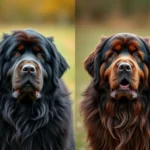
Introduction
Dog breeds are classifications of domestic dogs that share specific characteristics, such as appearance, behavior, and purpose. These distinctions not only help in identifying different breeds but also play a vital role in understanding their needs, care, and suitability for various lifestyles. Among the many breeds, the Chinook stands out due to its fascinating history and unique traits.
The Chinook is a remarkable breed that originated in the early 20th century in the United States, primarily bred for its strength and endurance as a sled dog. Known for its friendly disposition and intelligence, the Chinook has become a beloved companion for many families. This article aims to provide readers with a comprehensive overview of the Chinook breed, covering its history, physical characteristics, temperament, care requirements, and suitability as a family pet.
Section 1: History of the Chinook
Origins
The Chinook breed was developed in the early 1900s by Arthur Treadwell Walden, who sought to create a versatile sled dog capable of performing various tasks in harsh winter conditions. The breed is a mix of several dog types, including the Greenland dog, St. Bernard, and German shepherd. The goal was to produce a strong, resilient dog that could pull sleds efficiently while also exhibiting a friendly demeanor.
Cultural Significance
The Chinook holds a significant place in American history, particularly in the context of sled dog racing and Arctic expeditions. These dogs were not only used for transportation but also played crucial roles in search-and-rescue missions and as companions for explorers. Their ability to work in teams and thrive in cold environments made them invaluable during early 20th-century exploration of the Arctic.
Recognition
The Chinook was recognized by the United Kennel Club (UKC) in 1991, and it has since gained popularity among dog enthusiasts. Although the breed remains relatively rare, it is celebrated for its historical significance and unique characteristics. Efforts continue to promote and preserve the breed, ensuring its legacy endures.
Section 2: Physical Characteristics
Size and Build
The Chinook is a medium to large-sized dog, typically standing between 21 to 27 inches tall at the shoulder. Males tend to weigh between 70 to 90 pounds, while females range from 50 to 70 pounds. They possess a sturdy build, exhibiting both strength and grace, which is essential for their original purpose as sled dogs.
Coat and Color
The Chinook has a double coat that keeps it warm in cold climates. The outer coat consists of medium-length, straight fur, while the undercoat is dense and soft. The breed can come in various colors, including shades of tawny, gold, and brown, often with white markings on the face, chest, and legs. Regular grooming is necessary to manage shedding and maintain coat health.
Distinctive Features
One of the Chinook’s most distinctive features is its expressive face, often characterized by a broad skull and a slightly tapered muzzle. Their ears are medium-sized, erect, and can sometimes fold at the tips. The breed’s bushy tail typically curls over the back, adding to its overall striking appearance.
Section 3: Temperament and Behavior
General Temperament
The Chinook is known for its friendly and sociable nature. These dogs are generally good-natured and enjoy being around people, making them excellent family pets. Their intelligence and eagerness to please contribute to their adaptability in various environments.
Socialization Needs
Early socialization is crucial for Chinooks to develop into well-rounded adults. Exposing them to various people, animals, and situations will help them become more confident and less prone to anxiety or aggression. Regular interactions with other dogs and pets are essential for their social development.
Training Requirements
Training a Chinook can be a rewarding experience, as they are intelligent and quick learners. However, consistent and positive reinforcement methods work best. Engaging training sessions that incorporate play and mental stimulation can keep these dogs motivated. Basic obedience training is essential, and introducing them to more advanced commands can enhance their skills.
Section 4: Care and Maintenance
Diet and Nutrition
Feeding your Chinook a balanced diet is vital for its overall health. High-quality dog food that meets their nutritional needs should be provided, considering their size and activity level. It’s recommended to consult with a veterinarian to determine the best diet, portion sizes, and any necessary supplements.
Exercise Requirements
The Chinook is an active breed that requires regular exercise to maintain both physical and mental health. Daily activities such as walks, runs, and playtime are essential for preventing boredom and destructive behaviors. Engaging in activities like hiking or participating in dog sports can also provide the stimulation they need.
Grooming and Health Care
Regular grooming is important for maintaining the Chinook’s coat. Brushing at least once a week helps manage shedding and keeps the fur healthy. Bathing should be done as needed, typically every few months, unless the dog becomes particularly dirty. Regular veterinary check-ups are crucial for monitoring health and addressing any potential issues early on.
Section 5: Chinook as a Family Pet
Suitability for Families
The Chinook is well-suited for family life due to its friendly nature and adaptability. They thrive in homes where they receive plenty of attention and exercise. Their loyalty and affectionate demeanor make them great companions for both adults and children.
Interaction with Children
Chinooks are generally good with children, enjoying playtime and being part of family activities. However, it is essential to teach children how to interact with dogs safely and respectfully. Supervision during play and teaching kids to recognize a dog’s body language can foster positive interactions.
Living Situations
While Chinooks can adapt to various living situations, they do best in homes with ample space for exercise. A house with a yard is ideal, allowing them to run and play safely. However, they can also thrive in apartments, provided they receive sufficient daily exercise and mental stimulation.
Section 6: Adoption and Breeding
Finding a Chinook
If you’re interested in adding a Chinook to your family, it’s essential to find reputable breeders or adoption centers. Researching breed-specific rescues and attending dog shows can help connect you with trustworthy sources. Always ask about health testing and socialization practices when considering a breeder.
Cost of Ownership
Owning a Chinook involves various financial considerations. Initial costs may include adoption fees or purchase prices, which can range from $1,000 to $2,500. Additionally, you should budget for ongoing expenses, such as food, grooming, veterinary care, and training classes.
Ethical Considerations
When considering adding a Chinook to your family, it’s crucial to prioritize ethical breeding practices. Supporting responsible breeders who prioritize the health and well-being of their dogs contributes to the overall health of the breed. Adopting from shelters and rescues is also a wonderful option, helping to provide homes for dogs in need.
Section 7: Frequently Asked Questions (FAQs)
Common Queries
What is the lifespan of a Chinook?
The average lifespan of a Chinook is around 12 to 15 years, depending on genetics and overall health.
Are Chinooks compatible with other pets?
Yes, Chinooks can get along well with other pets if properly socialized from a young age. Early exposure to various animals can help foster positive relationships.
How do I train a Chinook?
Training a Chinook requires patience and consistency. Using positive reinforcement techniques, such as treats and praise, can motivate them to learn commands and behaviors.
Conclusion
In summary, the Chinook is a unique and versatile breed known for its friendly temperament and historical significance. Understanding the breed’s characteristics and care requirements is essential for potential owners. The Chinook can make a wonderful addition to a family, providing companionship and joy for years to come. As you consider welcoming a Chinook into your home, remember the importance of responsible ownership and the fulfillment that comes from sharing your life with such a remarkable dog.









